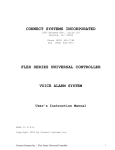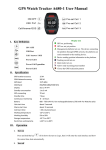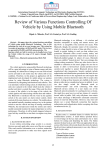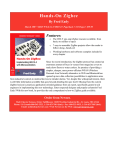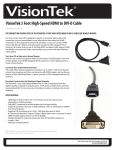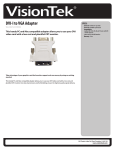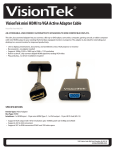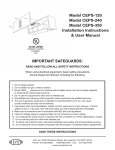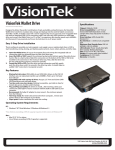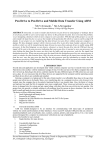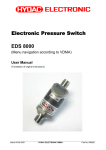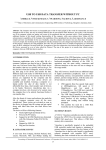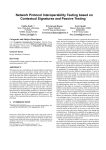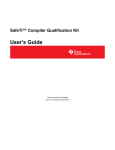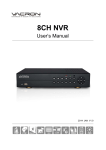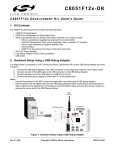Download Multipoint Wireless Data Acquisition System for Smart Vehicle
Transcript
ISSN 2249-6343 International Journal of Computer Technology and Electronics Engineering (IJCTEE) Volume 2, Issue 1 Multipoint Wireless Data Acquisition System for Smart Vehicle Prof. Vishal A. Aher Prof. Satish M. Turkane Prof. Sandip S.Turakne Prof. Rahul N. Kadu Prof. Sachin S. Taware Abstract— In the design of vehicles of public transport as much as private, it is important to know the real load properties which are put under the vehicle. Although typical load histories are available, these files were obtained in other countries where the conditions of the ways and the operation of the vehicles are very different. In order to be able to obtain histories of loads in the conditions of our country, a system based on a wireless sensing modules network has been developed to measure deformations, temperature and accelerations in multiple points of the vehicle in real time. The obtained data of each sensor is prepared, processed, stored and transmitted in time intervals towards a receiver, which is in charge to send them to a Internet server for its storage, visualization and analysis for any user connected to the network who have accessibility to the collected information and can make the pertinent procedures and actions. In this work the design of the instrumentation system is based on a wireless sensing modules network and its uses the GPRS protocol which is based on GSM cellular technology, it permit send all the data received from each wireless module to the server host. Index Terms—About four key words or phrases in alphabetical order, separated by commas. I. INTRODUCTION In today’s world where science has made amazing advances so have the recent cars. These cars are more advanced than ever. They have more speed, state of the art engines and are very closely to these reasons there is a need to adapt a device which can continuously monitor all the various parameters of car. We have design such a system which, in case of accident will records all the parameters and also help us to prevent any accident to happen in certain extends. Manuscript received Oct 15, 2011. 1 Vishal A. Aher, Department of Electronics and Telecommunication Engineering,, P.R.E.C.-Loni, (email: [email protected]) mobile-+917588024904 2 Satish S. Turkane, Department of Electronics and Telecommunication Engineering,, P.R.E.C.-Loni,Mobile-+918888787878 3 Sandip S. Turakne, Department of Electronics and Telecommunication Engineering,, P.R.E.C.-Loni,Mobile-+919763720719 4 Rahul.N.Kadu, Department of Electronics Engineering,, P.R.E.C.-Loni, Mobile-+919860539677 5 Sachin S. Taware, Department of Electronics and Telecommunication Engineering,, P.R.E.C.-Loni, (e-mail: [email protected]). Loni, India, Mobile: +919096349923 The project is developed to record informational data, such as: speed of vehicle, temperature of the engine (30 seconds before), etc. to revolutionize the field of motor vehicle accident investigation. It can also use for vehicle mapping and accident alert with the help of GPS and GSM technology. This project is designed with the help of Embedded Technology. Embedded systems are playing important roles in our lives every day, even though they might not necessarily be visible. An embedded system can be defined as a control system or computer system designed to perform a specific task and also be defined as a single purpose computer. Some of the embedded systems we use every day are control the menu system on television, the timer in a microwave oven, a cell phone, an MP3 player or any other device with some amount of intelligence built-in. An embedded system contains at least one microprocessor which performs the logical operations for the system. Many embedded systems use one or more microcontrollers, which are a type of microprocessor that emphasizes self-sufficiency and cost-effectiveness, instead of a general-purpose microprocessor. A typical microcontroller contains sufficient memory and interfaces for simple applications, whereas general-purpose microprocessors require additional chips to provide these functions, including at least one ROM chip to store the software.[2] This project includes features like fuel leakage detection, engine temperature, alcohol detection, speed measurement, location of car using Global Positioning System, all the data is recorded on a smartcard. Using GSM technology the current detail of the car can be sent to a dedicated mobile. The project is developed using ARM microcontroller. A. Aim of Project Our aim is to design “Wireless Data Acquisition System for Vehicles” because there are many parts related to vehicles where fault may occur. To recover from fault we require various data for analysis. So, here in this project we are going to acquire data related to various parts of vehicles, such as temp of engine, fuel leakage, speed etc. After data acquisition we will send this data to internet or can be stored for further analysis. B. Brief history After an airplane crash, you often hear news reports about federal investigators examining the black box or flight data recorder. 208 ISSN 2249-6343 International Journal of Computer Technology and Electronics Engineering (IJCTEE) Volume 2, Issue 1 Such electronic data can be critical in reconstructing the accident. All airplanes have a “black box” (flight data recorder) which provides data about the last moments before crash. Similarly, most automobiles and trucks have on-board devices that record information about a crash. When it comes to motor vehicle collisions, one should be aware of the various electronic modules that may record data, what data they contain and how it can be used. If a car has a WDASV, what should be there in the WDASV? WDASV s do not record conversations. Car WDASV s doesn’t keep a running average of how fast you drive. They don’t record whether you come to a complete stop at the last stop signal minute before the crash. Event data recorders in cars only capture the crash data the car manufacturer wants for its own purposes. Typically, the car manufacture only wants crash data limited to the few seconds before, during and after a crash. Most car WDASV s do not capture any data unless there is a collision that is severe enough to cause the airbag to deploy. Yet, still, the limited data captured is vital information about the crash. There are no industry guidelines as to what WDASV in cars should contain. Different manufacturers record different information. For example, the GM devices record vehicle speed, engine speed, brake application, throttle position and whether the seatbelts were fastened. Most commonly WDASV typically record about five to twenty seconds worth of data on four key items: speed (e.g., how far the accelerator is depressed, engine speed, engine rpm), whether the brakes are engaged (some time the point before the impact that the brakes were applied), whether the driver and passengers were wearing seatbelts.[1] Widespread deployment of WDASV, sometimes called “black boxes”, promise a new and unique glimpse of the events that occur during a highway traffic collision. By carefully collecting and analyzing the details provided by the growing number of WDASV -equipped vehicles, state transportation agencies, federal agencies, and the highway safety research community have an unprecedented opportunity to understand the interaction of the vehicle-road side driver system as experienced in thousands of highway accidents each year. The WDASV units for motor vehicles were firstly planned in early seventies, when the USA Nation Bureau for Road–Traffic Safety started using device, which was able to work-out the analog signal and able to save gained data. In 1974 were thousand cars equipped by this device. Therefore it covered many groups of drivers. Thanks to this device the analysis of many accidents was possible and it recorded whole process of deceleration of the vehicle, especially Δv. During this year General Motors introduced airbag system in several model lines. There was implemented a special unit whose main characteristic was a data collection and its evaluation whether the airbag should have been activated. In 1976 GM introduced SDM module (Sensing and Diagnostic Module), which was improved to so called DERM (Diagnostic and Energy Reserve Module) in 1990. The main target of this module consists of recording and saving data from measuring sensors including error messages at the time when the airbag is activated. In 1990 GM installed the first sophisticated electronic accident data recorder in F1 cars. As it is clear from the article above, firstly the mentioned units were designed as a diagnostic tool for a determination of the reasons for the airbag activation. Later, units were used for accident reconstructions. It was asked by insurance companies and police. In 1992, thanks to the co-operation of Great Britain, the Netherlands and Belgium the European project called SAMOVAR (Safety Assessment Monitoring on Vehicle with Automatic Recording) came into existence. This project is targeted on motor cars monitoring by black boxes and its possibilities to improve road – traffic safety. During years, there were more attempts of some alternatives of the black box but it was not widespread used. The next step was to add a vehicle speed sensor to allow the WDASV to provide the cruise control, electronically, with no throttle linkage. From there it was a fleet sales step to add additional sensors and programming to track driver performance. The black box should be called WDASV - and it should work like the same unit in airplanes. This device is being developed for usage in all types of motor cars used in the road transportation WDASV project standardizes and defines how the data will be gained, recorded and transferred. The next thing that is mentioned by WDASV is how these data as date, time, place, speed, etc. will be recorded. These data could be used for better development of the passive – safety systems. The human behavior is the main factor for the road – traffic safety. Concerning this reason it is very important to motivate people to behave on road more responsible. Following and recording of a driver’s behavior could lead to confrontation with the driver’s statement, later. It means that drivers, who are aware of this, change their behavior before the accident happen. This should lead to decrease of road accidents. 209 ISSN 2249-6343 International Journal of Computer Technology and Electronics Engineering (IJCTEE) Volume 2, Issue 1 II. BLOCK DIAGRAM AND DESCRIPTION Whenever accident takes place the accident interrupt block gives interrupt to the ARM-7 microcontroller. Through serial communication block the WDASV is interfaced the PC. With this interfacing the stored data is transferred serially to PC, for the analysis purpose. A. Block Diagram 1) Alcohol Sensor ARM-7 microcontroller first reads the value of alcohol sensor if any alcohol is detected in the driver’s cabin the ignition is turned off. 2) LPG gas sensor ARM-7 microcontroller also continuously scans for LPG gas leakage sensor. If any LPG gas leakage is detected then display the gas concentration on LCD and buzzer on for indicate or alert the driver to avoid an accident. 3) Accident switches We are connecting impact switches on to the exterior of the car. As soon as the accident happens the corresponding accident switch is pressed as soon as the accident is detected. The ARM-7 microcontroller stores all this data on the ram memory. All these data is sent to the base unit via SMS. The µc uses “at” commands to initialize the mobile and send the SMS to the base unit. Fig.1 Block diagram of wireless data acquisition system for smart vehicle. B. Block diagram description When you submit your final version, after your paper has been accepted, prepare it in two-column format, including figures and tables. Data Acquisition modes In data acquisition mode ARM-7 microcontroller acquires and stores different parameter of car. The main block of Wireless Data Acquisition System for Vehicles is ARM-7 micro controller which is heart of the WDASV which provides monitoring and controlling actions. It senses signals from input blocks and processes output blocks. The software program is stored in ARM-7 microcontroller on chip memory, according to which it provides the controlling actions. The on chip ADC converts these parameters into digital form and gives to the ARM-7 microcontroller. The status of door status i.e. whether the door is opened or closed is sensed by door status block and gives the corresponding signal to microcontroller. The speed of the vehicle is sensed by the speed sensor and this speed is measured in RPM by ARM-7 microcontroller. With the help of keyboard block the driver can enter the password along with cabin temperature. The LCD block is provided for visual display of the message and password. Also it continuously displays the measured parameters. The RTC provides real time clock depending on which the various events occur. 4) Fuel Level Indicator For fuel level indication float type fuel level indicator is used. As the level of fuel varies the resistance of fuel level indicator changes and corresponding value displayed on screen. 5) Speed of vehicle (RPM) Speed of vehicle is measured on the basis of tachometer for this we use IR sensor TLP 1031A. 6) Temperature It continuously monitors the temperature of engine as well as cabin & sends its value to microcontroller. If temperature of engine or cabin exceeds desire value then system alerts to driver. 7) Door and Bonnet The door and bonnet status is checked with the help of limit switches. If any of the door or bonnet is not closed properly, an audio indication is given by the buzzer. 8) Obstacle To detect any obstacle, an optical sensor is used. If any obstacle is observed, an audio indication is given by the buzzer. SMS Sending Mode In this mode the WDASV sends either SMS or directly dials calls to prerecorded numbers. The main blocks of this mode are microcontroller, mode interfacing unit and accident interrupt. 210 ISSN 2249-6343 International Journal of Computer Technology and Electronics Engineering (IJCTEE) Volume 2, Issue 1 As accident occurs to the car equipped with WDASV the accident interrupt block generates an interrupt. On receiving this interrupt microcontroller either sends SMS or dials call to prerecorded mobile number. Why ARM7? According to the system requirements including low power consumption, low cost, small volume, multi-functions and real-time, Philips Company’s LPC2141/42/44/46/48 is a much better choice. LPC2141/42/44/46/48 processor belongs to one of ARM-7TDMIS ARM processors. III. ALGORITHM AND WORKFLOW OF THE SYSTEM A. Algorithm of system work 1) Start 2) Sense the parameter from various parts of the vehicle 3) Send the collected information to the ADC 4) Then ARM process the data 5) If sensed parameters exceeds their limit then ARM LPC2148 send command to relay to stop the ignition. 6) Send the data over GPS and GSM 7) If the parameter does not exceeds the limit it will continued. 8) Exit IV. ADVANTAGES AND DISADVANTAGES A. Advantages 1) Security of vehicle. 2) Record driving data, collision data and position data. 3) Analyze the accidents detail. 4) Send location of car and its maintenance to base station through GPS & GSM technique. 5) Sense gas & fuel leakage and display its status on car monitoring system. 6) Detect if the driver is drunk or not. 7) Detect if the driver is feeling sleepy. 8) Shows engine temperature. 9) Remote place data can be acquiesced. 10) Various difficult data like vibration can be measured. 11) Data acquiesced is placed on internet. 12) Due data present on internet can be acquiesced at any time. 13) This data acquiesced from one country to another country by use of internet. B. Disadvantages 1) Cost of some sensor is very high such as vibration sensor 2) Damage of sensor cannot be detected. V. APPLICATION & FUTURE SCOPE B. Work flow of the system A. Application 1) .Personal vehicle The main application of black box is for personal vehicle use if any unfortunate accident had occurred to a vehicle fitted with black box then immediate help can be provided to the victimized car on receiving SMS. 2) Insurance companies Most of the time of accident is false .so insurance companies can implement this car black box in the insured vehicle and as a data before and at the time of accident is locked into black box. the insurance company can easily analyze the data recorded. And they can find out whether the accident had made or occurred. And so the false claim is avoided. 3) .Research and development of vehicle In testing the vehicle in R and D sent a engineers required data at various speed and time. But this data is not available exactly as it is not possible to measure the data for every second and to measure the number of parameters at the same time. But if black box is used the data can be made available for each and every second with very high accuracy. Black box not only makes the data available but with the help of LABVIEW software the data can be plotted in graphical form that is speed Vs time ,engine temp. Vs time. Fig. 2 Flow chart of system working 211 ISSN 2249-6343 International Journal of Computer Technology and Electronics Engineering (IJCTEE) Volume 2, Issue 1 4) Military applications Military vehicles carry ammunition from one place to other for e.g. in Kashmir military vehicles can be fitted with car black box so if militants had attacked or damaged the vehicle immediate SMS is send to military based station and this ammunitions can be made save from wrong hands. 5) Traveling agencies and state transport(ST) The black box can also be useful for traveling agencies and state transport as in today’s scene number of accidents are happened to buses and many people die in this accidents. Due to immediate help is not made available. But if this vehicles are equipped with black box immediate help can be made available to accident place on receiving SMS and life of many people can be saved. B. Future Scope [11] Workshop on Environmental Engineering, The Contribution to Quality and Relibility, organized by Department of Electronics, Center for Relibility,Channai, July 1992. Prof.Vishal A. Aher, working as a lecturer in dept.of E&TC at Pravara Rural Engineering College, Loni doing his PG in Embedded and VLSI Prof.Satish S. Turkane, working as a Ass. Professor & H.O.D. in dept.of E&TC at Pravara Rural Engineering College, Loni. Pursued his PG in Digital Electronics. Prof.Sandip S. Turakne, working as a lecturer in dept.of E&TC at Pravara Rural Engineering College, Loni doing his PG in Embedded and VLSI Prof. Rahul.N.Kadu, working as a lecturer in dept.of E&TC at Pravara Rural Engineering College, Loni doing his PG in Embedded and VLSI, Prof. Taware Sachin S. working as a lecturer in dept.of E&TC at Pravara Rural Engineering College, Loni doing his PG in Embedded and VLSI and working on the research entitled Embedded E-documentation and Magnetic Resonance Cavity. 1) A Front Camera can be used for Lane Tracking purpose. 2) Long range IR sensors can be used in front to avoid vehicle collision 3) A Camera can be used inside the car for vigilance purpose. 4) Instead of a Microcontroller we can use a CPLD chip since the CPLD incorporates many more features than a Microcontroller. VLSI/VHDL can be used for CPLD programming. VI. RESULT AND CONCLUSION Hence we conclude that this project not only useful for acquiring data but we can analysis and also control the parameter. Thus it is helpful to avoid accident, gas leakage, very high temp etc Thus it becomes very easy to acquire and analyze the data of moving vehicles. With help of this project we can get data anywhere in the world because we are using GPRS module to place data on internet. Future scope of that is to control the accidents and positioning the accidental vehicle. REFERENCES [1] D Anderson, Karl F., “The Constant Current Loop: A New Paradigm for Resistance Signal Conditioning”, NASA TM-104260, October 1992 [2] Analog Devices. “±1g to ±5g Single Chip Accelerometer with Signal Conditioning”. Norwood, MA, USA, 1996 [3] “C8051F120/1/2/3 – C8051F124/5/6/7 User’s Manual”, Cygnal Integrated Products, 2002. [4] “TRF-2.4Ghz Reference Manual”, Laipac [5] Slows Synes Wright, “ARM System Developers Guide” Elsevier publication [6] www.alldatasheets.com [7] User manual for Visiontek GPS Vehicle Tracking unit 84VT Available: http\\www.visiontek.co.in [8] JSS-55555 Standard revision 2, Environmental Test Method for Electronic and Electrical Equpiment, Revised: 2000. [9] MIL Standard 810 E (Environmental), Revised: July 1989. [10] Seminar on Environmental testing of Electronic part and Products, organized by Electronics Testing and Development Center (ETDC) Pune and Electronics Regional Laboratory (ERTL) west Mumbai, January 1996. 212





